Analyzing Costing Methods and Planning Tools in Management Accounting
VerifiedAdded on 2023/02/02
|20
|4271
|61
Report
AI Summary
This report provides a detailed analysis of management accounting, beginning with a comparison of marginal and absorption costing methods, highlighting the differences in profit calculation and the suitability of absorption costing for providing a comprehensive view of cost and profitability. It explores the use of marginal costing in cost control, product costing, and decision-making, while also explaining the reasons for profit variances under different costing methods. Furthermore, the report discusses various planning tools used in management accounting, including fixed, flexible, and incremental budgets, outlining their advantages and disadvantages. It evaluates how organizations adapt management accounting to respond to financial problems and how management accounting contributes to sustainable success, concluding with an assessment of how planning tools aid in solving financial issues.
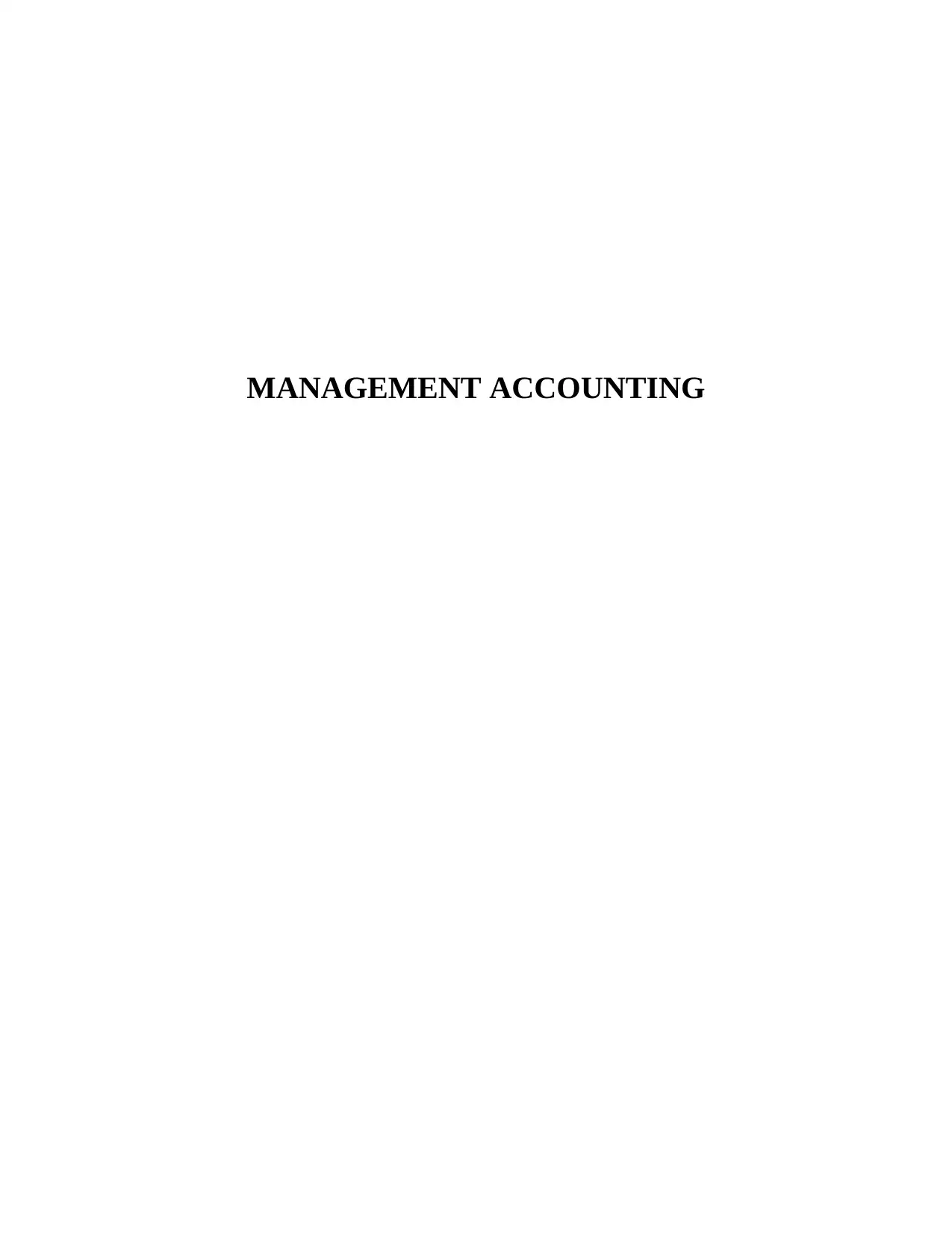
MANAGEMENT ACCOUNTING
Paraphrase This Document
Need a fresh take? Get an instant paraphrase of this document with our AI Paraphraser
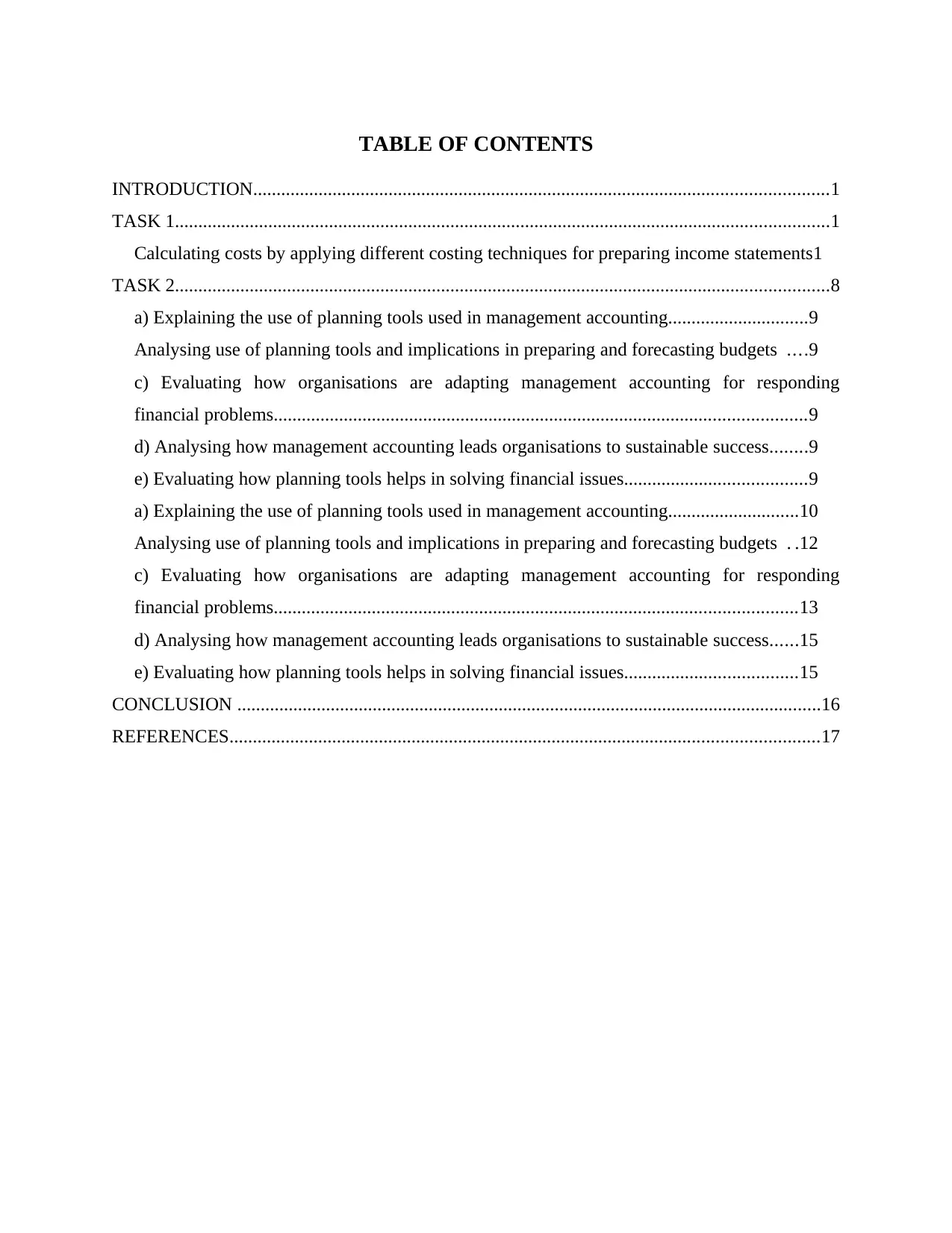
TABLE OF CONTENTS
INTRODUCTION...........................................................................................................................1
TASK 1............................................................................................................................................1
Calculating costs by applying different costing techniques for preparing income statements1
TASK 2............................................................................................................................................8
a) Explaining the use of planning tools used in management accounting..............................9
Analysing use of planning tools and implications in preparing and forecasting budgets ....9
c) Evaluating how organisations are adapting management accounting for responding
financial problems..................................................................................................................9
d) Analysing how management accounting leads organisations to sustainable success........9
e) Evaluating how planning tools helps in solving financial issues.......................................9
a) Explaining the use of planning tools used in management accounting............................10
Analysing use of planning tools and implications in preparing and forecasting budgets . .12
c) Evaluating how organisations are adapting management accounting for responding
financial problems................................................................................................................13
d) Analysing how management accounting leads organisations to sustainable success......15
e) Evaluating how planning tools helps in solving financial issues.....................................15
CONCLUSION .............................................................................................................................16
REFERENCES..............................................................................................................................17
INTRODUCTION...........................................................................................................................1
TASK 1............................................................................................................................................1
Calculating costs by applying different costing techniques for preparing income statements1
TASK 2............................................................................................................................................8
a) Explaining the use of planning tools used in management accounting..............................9
Analysing use of planning tools and implications in preparing and forecasting budgets ....9
c) Evaluating how organisations are adapting management accounting for responding
financial problems..................................................................................................................9
d) Analysing how management accounting leads organisations to sustainable success........9
e) Evaluating how planning tools helps in solving financial issues.......................................9
a) Explaining the use of planning tools used in management accounting............................10
Analysing use of planning tools and implications in preparing and forecasting budgets . .12
c) Evaluating how organisations are adapting management accounting for responding
financial problems................................................................................................................13
d) Analysing how management accounting leads organisations to sustainable success......15
e) Evaluating how planning tools helps in solving financial issues.....................................15
CONCLUSION .............................................................................................................................16
REFERENCES..............................................................................................................................17
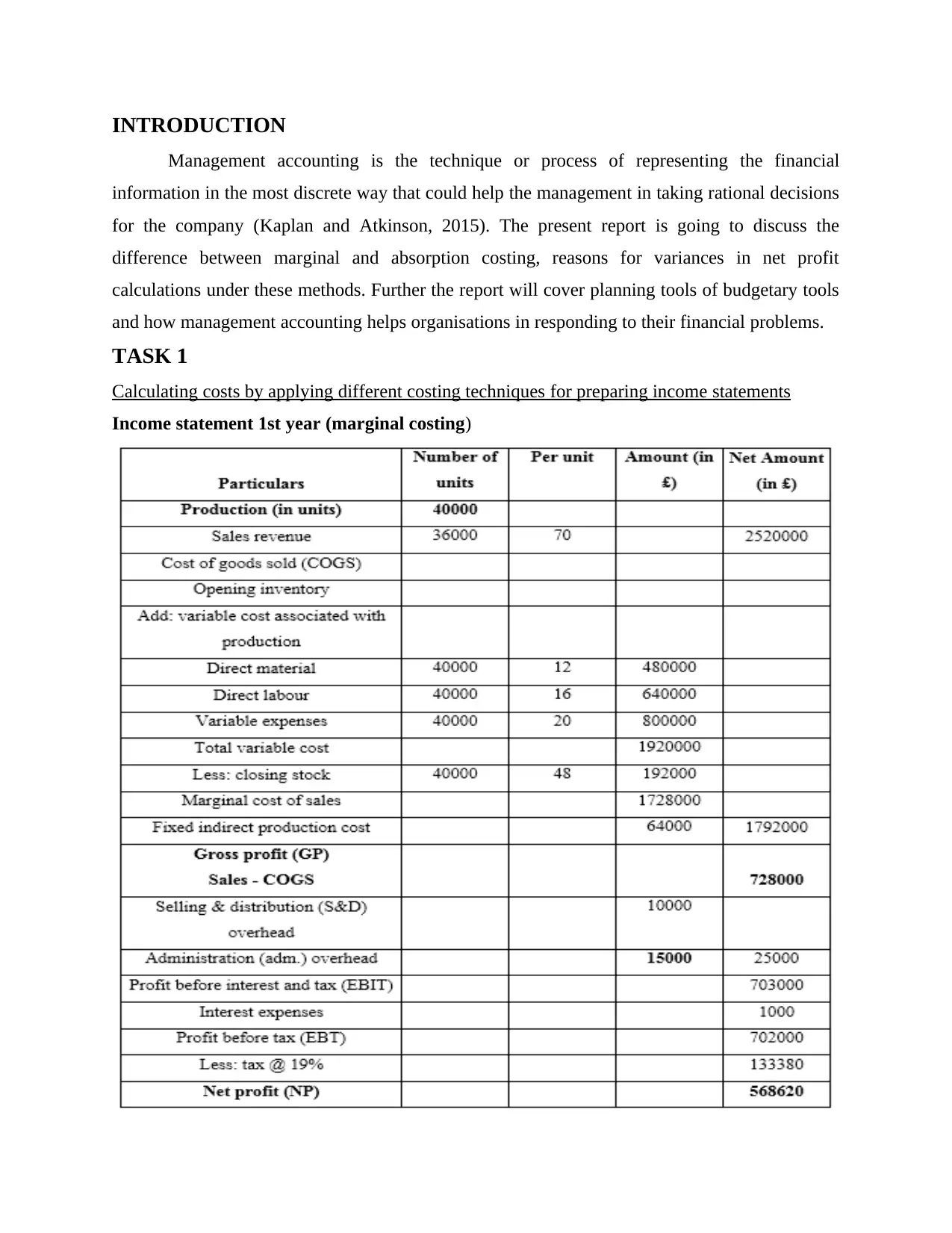
INTRODUCTION
Management accounting is the technique or process of representing the financial
information in the most discrete way that could help the management in taking rational decisions
for the company (Kaplan and Atkinson, 2015). The present report is going to discuss the
difference between marginal and absorption costing, reasons for variances in net profit
calculations under these methods. Further the report will cover planning tools of budgetary tools
and how management accounting helps organisations in responding to their financial problems.
TASK 1
Calculating costs by applying different costing techniques for preparing income statements
Income statement 1st year (marginal costing)
Management accounting is the technique or process of representing the financial
information in the most discrete way that could help the management in taking rational decisions
for the company (Kaplan and Atkinson, 2015). The present report is going to discuss the
difference between marginal and absorption costing, reasons for variances in net profit
calculations under these methods. Further the report will cover planning tools of budgetary tools
and how management accounting helps organisations in responding to their financial problems.
TASK 1
Calculating costs by applying different costing techniques for preparing income statements
Income statement 1st year (marginal costing)
⊘ This is a preview!⊘
Do you want full access?
Subscribe today to unlock all pages.

Trusted by 1+ million students worldwide
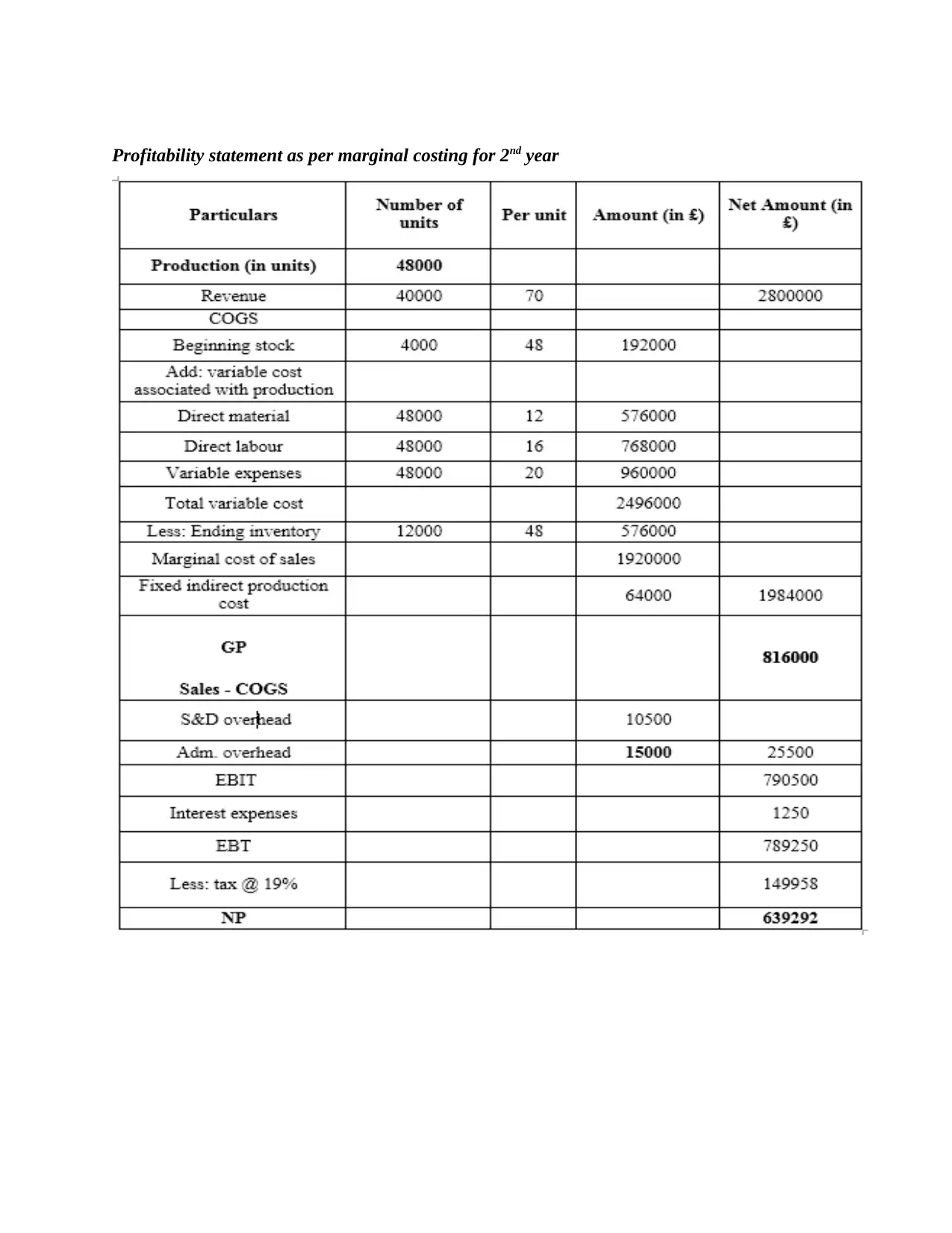
Profitability statement as per marginal costing for 2nd year
Paraphrase This Document
Need a fresh take? Get an instant paraphrase of this document with our AI Paraphraser
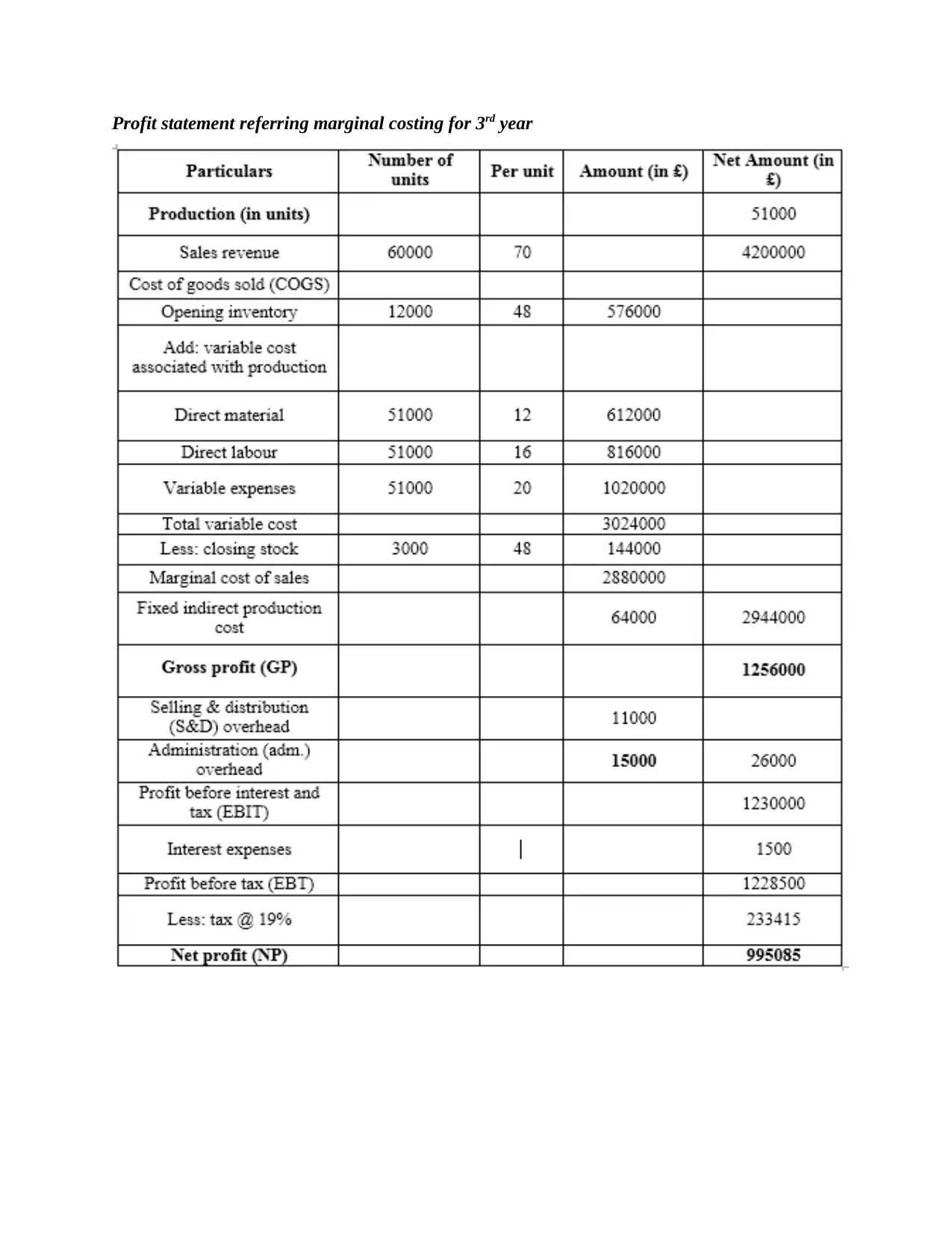
Profit statement referring marginal costing for 3rd year
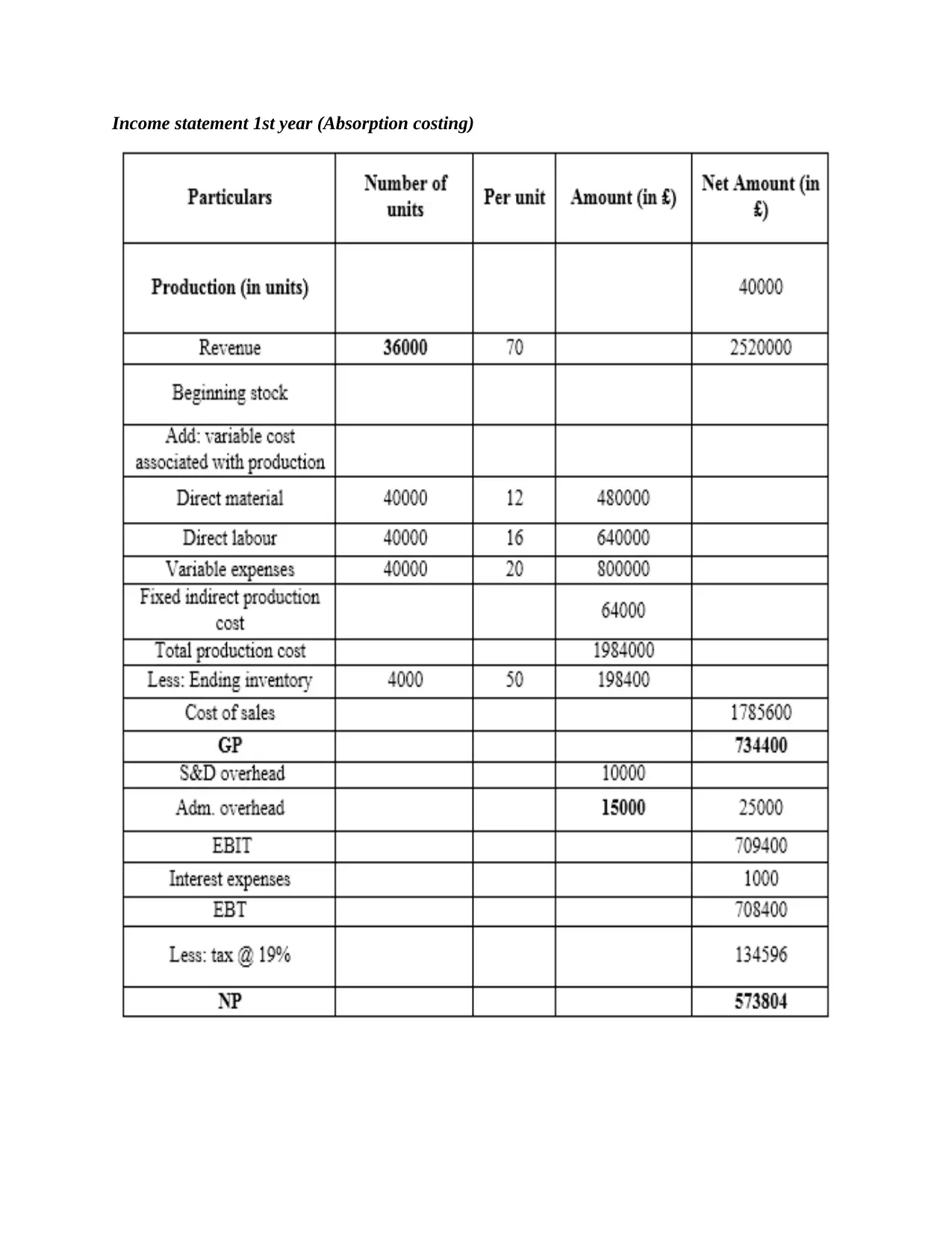
Income statement 1st year (Absorption costing)
⊘ This is a preview!⊘
Do you want full access?
Subscribe today to unlock all pages.

Trusted by 1+ million students worldwide
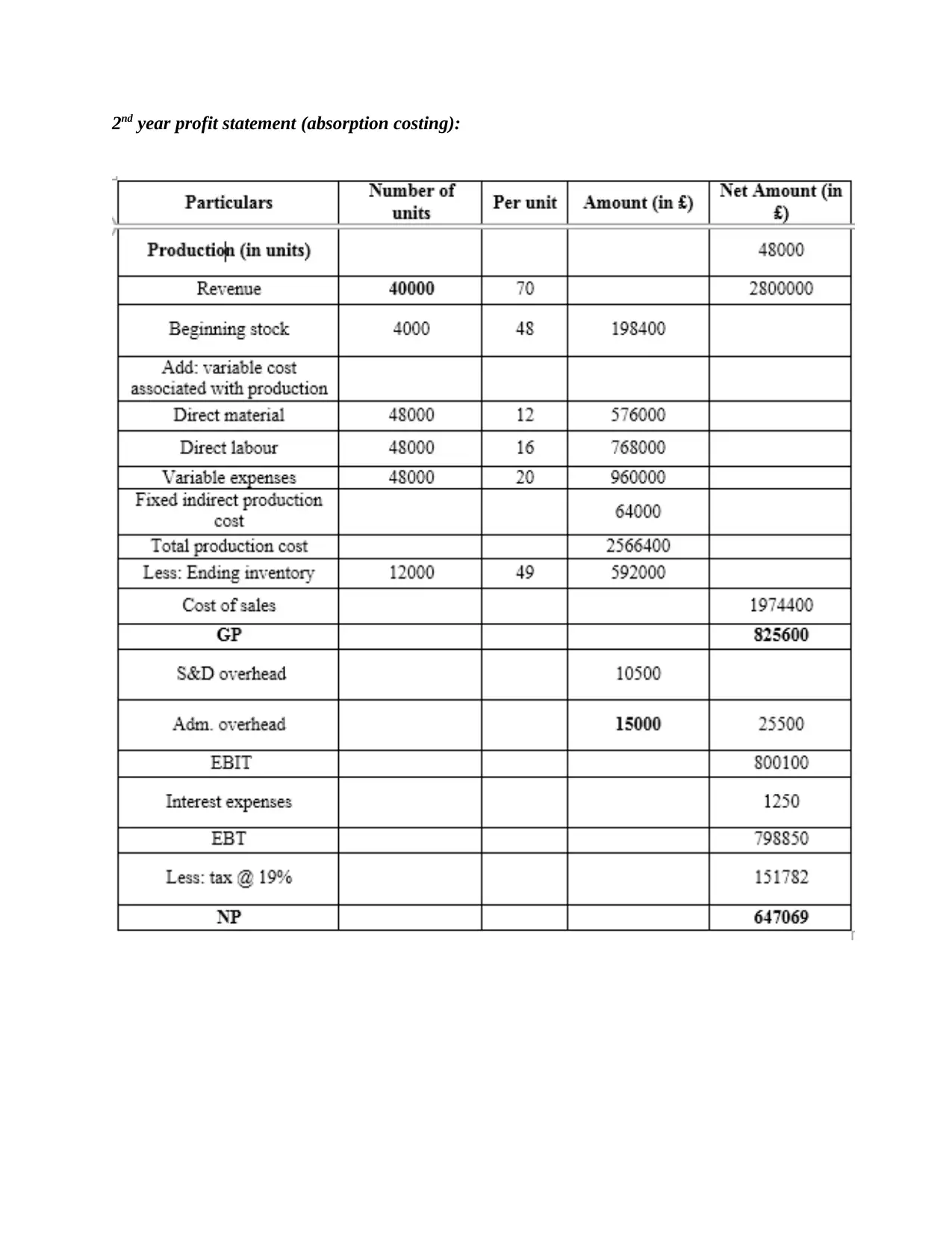
2nd year profit statement (absorption costing):
Paraphrase This Document
Need a fresh take? Get an instant paraphrase of this document with our AI Paraphraser
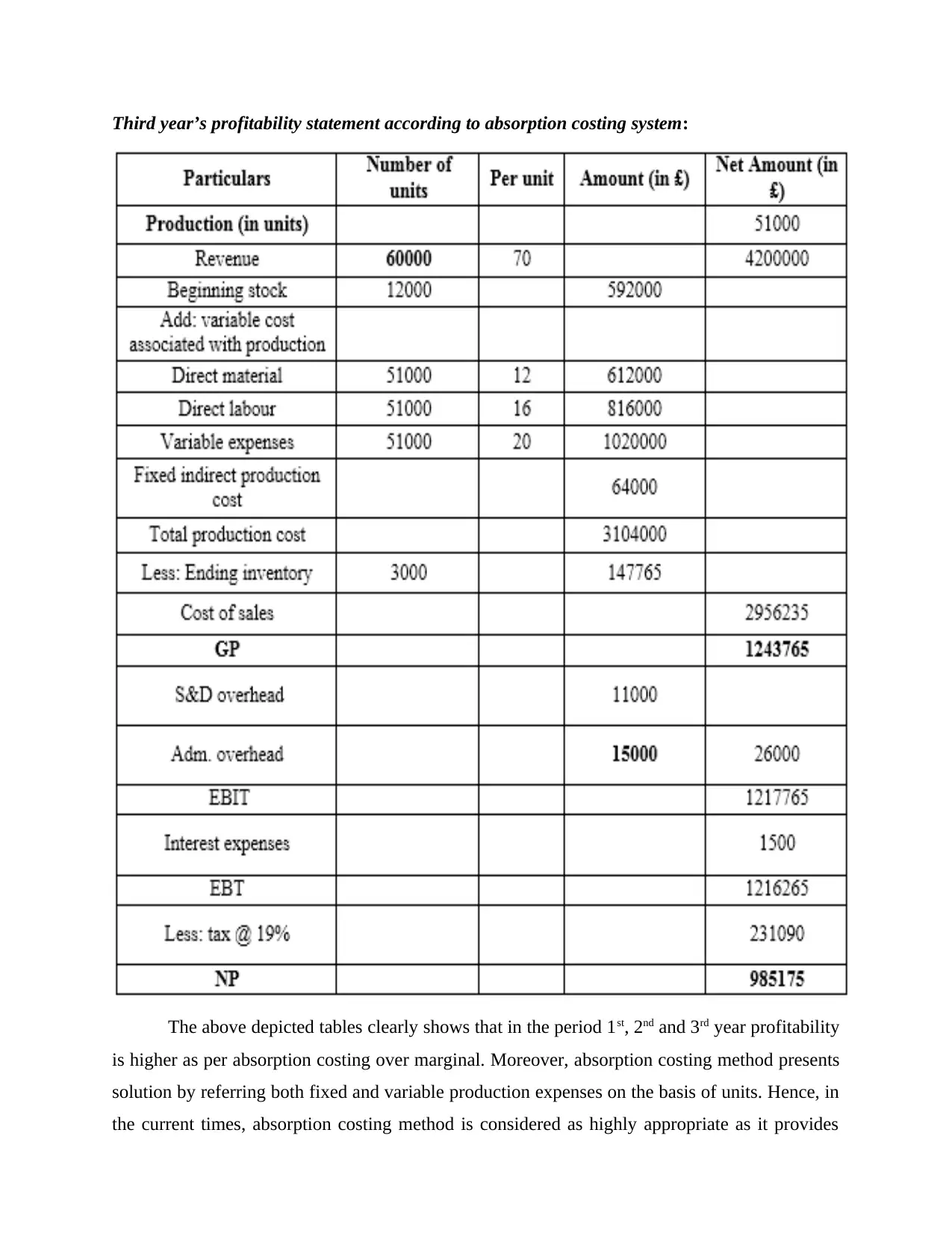
Third year’s profitability statement according to absorption costing system:
The above depicted tables clearly shows that in the period 1st, 2nd and 3rd year profitability
is higher as per absorption costing over marginal. Moreover, absorption costing method presents
solution by referring both fixed and variable production expenses on the basis of units. Hence, in
the current times, absorption costing method is considered as highly appropriate as it provides
The above depicted tables clearly shows that in the period 1st, 2nd and 3rd year profitability
is higher as per absorption costing over marginal. Moreover, absorption costing method presents
solution by referring both fixed and variable production expenses on the basis of units. Hence, in
the current times, absorption costing method is considered as highly appropriate as it provides
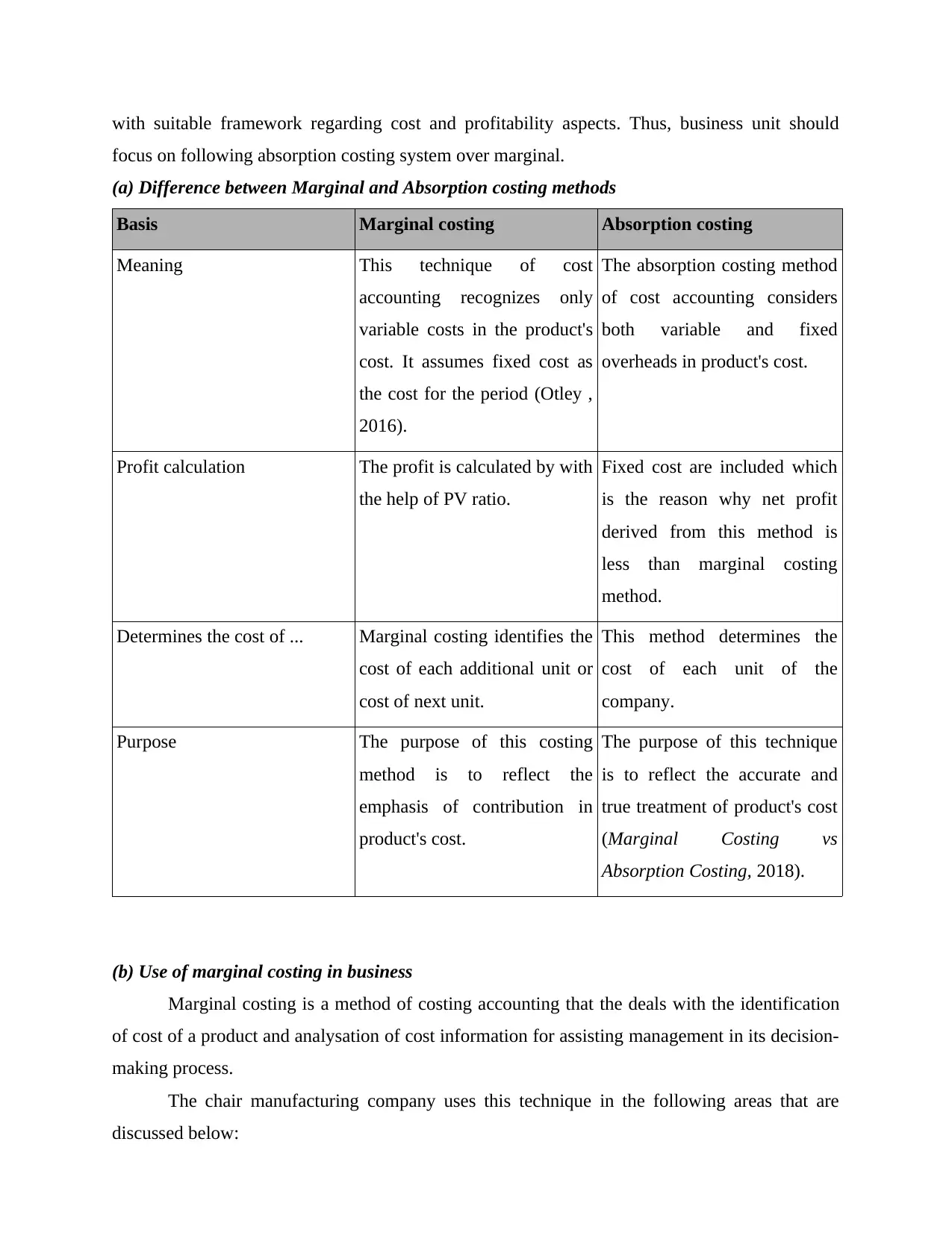
with suitable framework regarding cost and profitability aspects. Thus, business unit should
focus on following absorption costing system over marginal.
(a) Difference between Marginal and Absorption costing methods
Basis Marginal costing Absorption costing
Meaning This technique of cost
accounting recognizes only
variable costs in the product's
cost. It assumes fixed cost as
the cost for the period (Otley ,
2016).
The absorption costing method
of cost accounting considers
both variable and fixed
overheads in product's cost.
Profit calculation The profit is calculated by with
the help of PV ratio.
Fixed cost are included which
is the reason why net profit
derived from this method is
less than marginal costing
method.
Determines the cost of ... Marginal costing identifies the
cost of each additional unit or
cost of next unit.
This method determines the
cost of each unit of the
company.
Purpose The purpose of this costing
method is to reflect the
emphasis of contribution in
product's cost.
The purpose of this technique
is to reflect the accurate and
true treatment of product's cost
(Marginal Costing vs
Absorption Costing, 2018).
(b) Use of marginal costing in business
Marginal costing is a method of costing accounting that the deals with the identification
of cost of a product and analysation of cost information for assisting management in its decision-
making process.
The chair manufacturing company uses this technique in the following areas that are
discussed below:
focus on following absorption costing system over marginal.
(a) Difference between Marginal and Absorption costing methods
Basis Marginal costing Absorption costing
Meaning This technique of cost
accounting recognizes only
variable costs in the product's
cost. It assumes fixed cost as
the cost for the period (Otley ,
2016).
The absorption costing method
of cost accounting considers
both variable and fixed
overheads in product's cost.
Profit calculation The profit is calculated by with
the help of PV ratio.
Fixed cost are included which
is the reason why net profit
derived from this method is
less than marginal costing
method.
Determines the cost of ... Marginal costing identifies the
cost of each additional unit or
cost of next unit.
This method determines the
cost of each unit of the
company.
Purpose The purpose of this costing
method is to reflect the
emphasis of contribution in
product's cost.
The purpose of this technique
is to reflect the accurate and
true treatment of product's cost
(Marginal Costing vs
Absorption Costing, 2018).
(b) Use of marginal costing in business
Marginal costing is a method of costing accounting that the deals with the identification
of cost of a product and analysation of cost information for assisting management in its decision-
making process.
The chair manufacturing company uses this technique in the following areas that are
discussed below:
⊘ This is a preview!⊘
Do you want full access?
Subscribe today to unlock all pages.

Trusted by 1+ million students worldwide
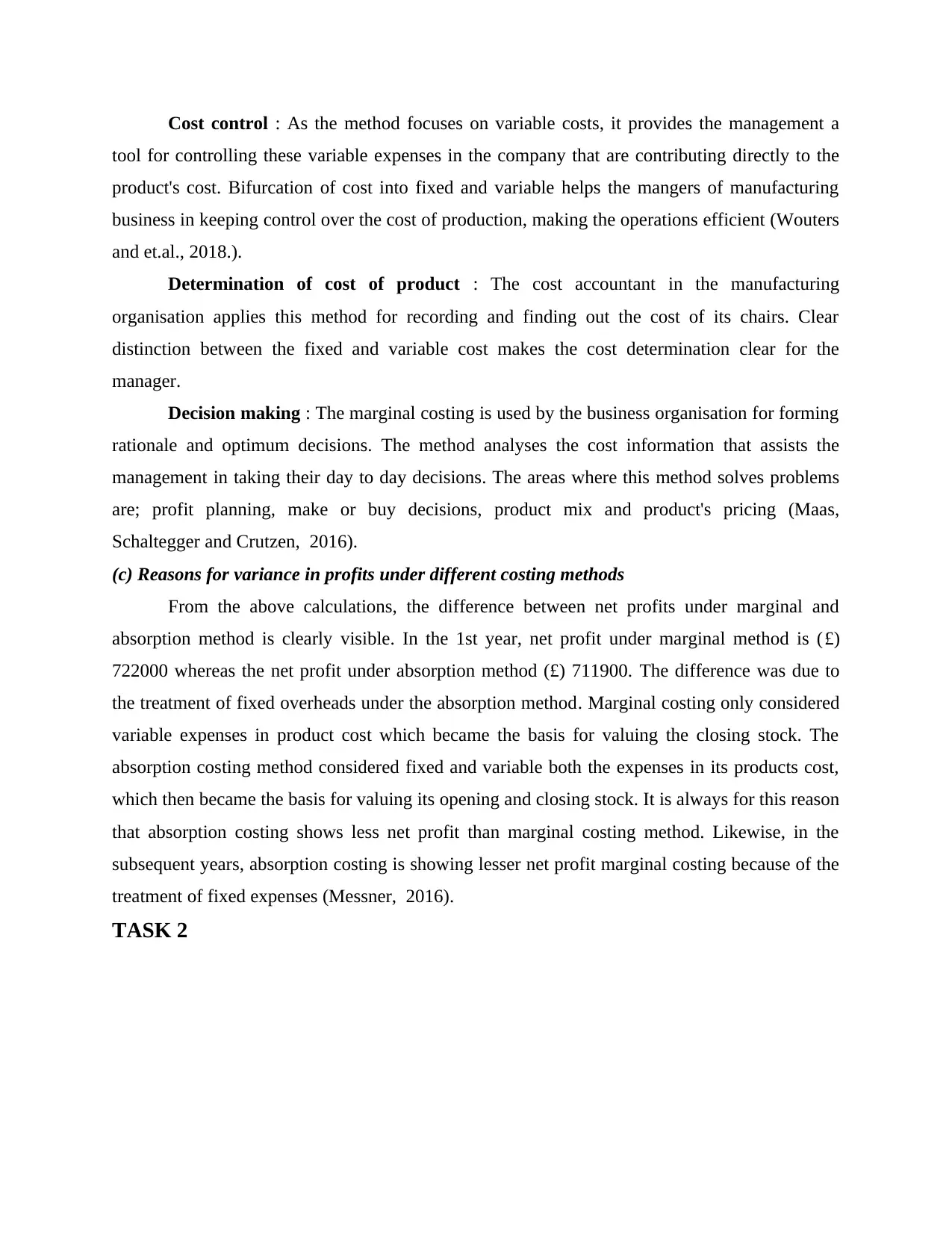
Cost control : As the method focuses on variable costs, it provides the management a
tool for controlling these variable expenses in the company that are contributing directly to the
product's cost. Bifurcation of cost into fixed and variable helps the mangers of manufacturing
business in keeping control over the cost of production, making the operations efficient (Wouters
and et.al., 2018.).
Determination of cost of product : The cost accountant in the manufacturing
organisation applies this method for recording and finding out the cost of its chairs. Clear
distinction between the fixed and variable cost makes the cost determination clear for the
manager.
Decision making : The marginal costing is used by the business organisation for forming
rationale and optimum decisions. The method analyses the cost information that assists the
management in taking their day to day decisions. The areas where this method solves problems
are; profit planning, make or buy decisions, product mix and product's pricing (Maas,
Schaltegger and Crutzen, 2016).
(c) Reasons for variance in profits under different costing methods
From the above calculations, the difference between net profits under marginal and
absorption method is clearly visible. In the 1st year, net profit under marginal method is (£)
722000 whereas the net profit under absorption method (£) 711900. The difference was due to
the treatment of fixed overheads under the absorption method. Marginal costing only considered
variable expenses in product cost which became the basis for valuing the closing stock. The
absorption costing method considered fixed and variable both the expenses in its products cost,
which then became the basis for valuing its opening and closing stock. It is always for this reason
that absorption costing shows less net profit than marginal costing method. Likewise, in the
subsequent years, absorption costing is showing lesser net profit marginal costing because of the
treatment of fixed expenses (Messner, 2016).
TASK 2
tool for controlling these variable expenses in the company that are contributing directly to the
product's cost. Bifurcation of cost into fixed and variable helps the mangers of manufacturing
business in keeping control over the cost of production, making the operations efficient (Wouters
and et.al., 2018.).
Determination of cost of product : The cost accountant in the manufacturing
organisation applies this method for recording and finding out the cost of its chairs. Clear
distinction between the fixed and variable cost makes the cost determination clear for the
manager.
Decision making : The marginal costing is used by the business organisation for forming
rationale and optimum decisions. The method analyses the cost information that assists the
management in taking their day to day decisions. The areas where this method solves problems
are; profit planning, make or buy decisions, product mix and product's pricing (Maas,
Schaltegger and Crutzen, 2016).
(c) Reasons for variance in profits under different costing methods
From the above calculations, the difference between net profits under marginal and
absorption method is clearly visible. In the 1st year, net profit under marginal method is (£)
722000 whereas the net profit under absorption method (£) 711900. The difference was due to
the treatment of fixed overheads under the absorption method. Marginal costing only considered
variable expenses in product cost which became the basis for valuing the closing stock. The
absorption costing method considered fixed and variable both the expenses in its products cost,
which then became the basis for valuing its opening and closing stock. It is always for this reason
that absorption costing shows less net profit than marginal costing method. Likewise, in the
subsequent years, absorption costing is showing lesser net profit marginal costing because of the
treatment of fixed expenses (Messner, 2016).
TASK 2
Paraphrase This Document
Need a fresh take? Get an instant paraphrase of this document with our AI Paraphraser
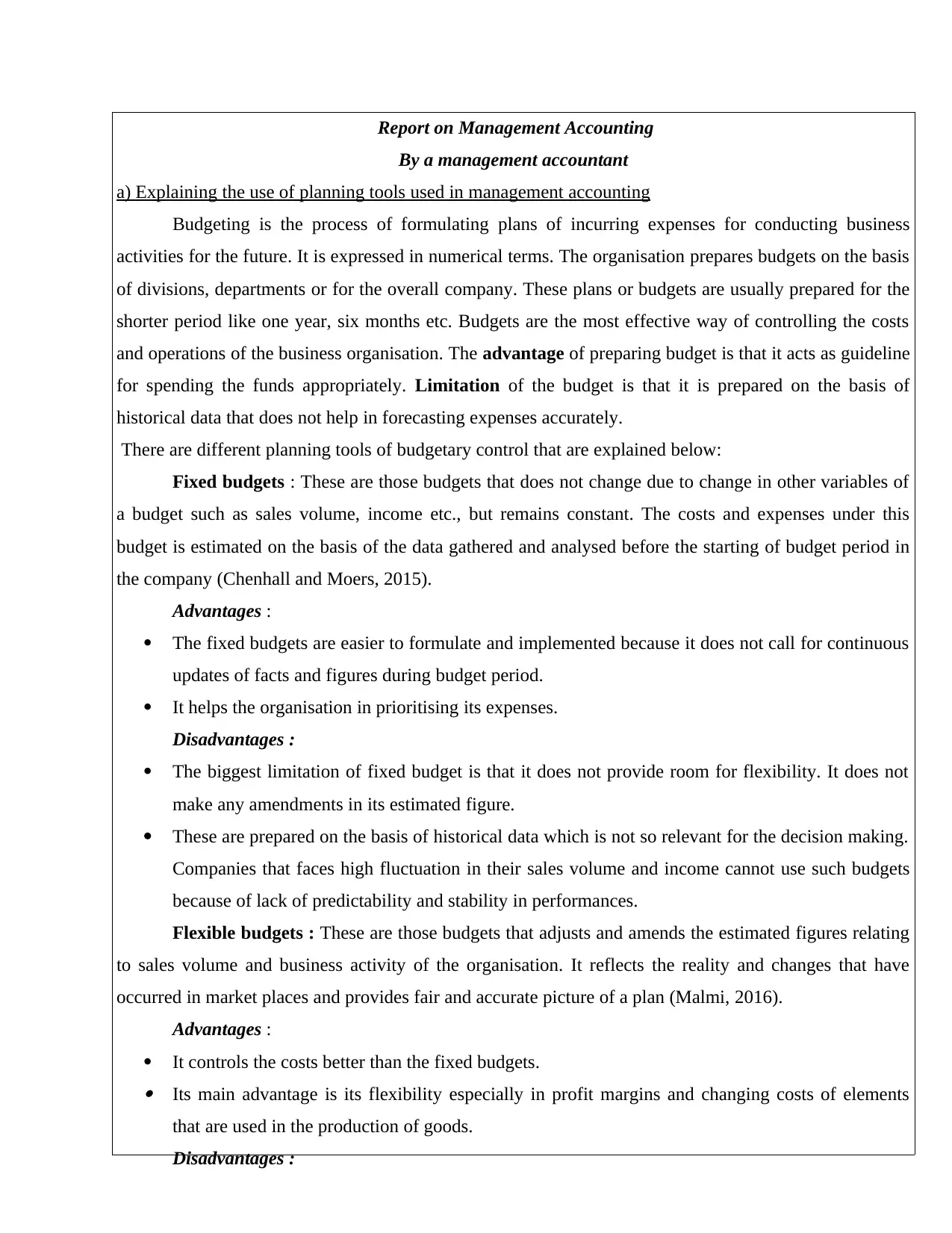
Report on Management Accounting
By a management accountant
a) Explaining the use of planning tools used in management accounting
Budgeting is the process of formulating plans of incurring expenses for conducting business
activities for the future. It is expressed in numerical terms. The organisation prepares budgets on the basis
of divisions, departments or for the overall company. These plans or budgets are usually prepared for the
shorter period like one year, six months etc. Budgets are the most effective way of controlling the costs
and operations of the business organisation. The advantage of preparing budget is that it acts as guideline
for spending the funds appropriately. Limitation of the budget is that it is prepared on the basis of
historical data that does not help in forecasting expenses accurately.
There are different planning tools of budgetary control that are explained below:
Fixed budgets : These are those budgets that does not change due to change in other variables of
a budget such as sales volume, income etc., but remains constant. The costs and expenses under this
budget is estimated on the basis of the data gathered and analysed before the starting of budget period in
the company (Chenhall and Moers, 2015).
Advantages :
The fixed budgets are easier to formulate and implemented because it does not call for continuous
updates of facts and figures during budget period.
It helps the organisation in prioritising its expenses.
Disadvantages :
The biggest limitation of fixed budget is that it does not provide room for flexibility. It does not
make any amendments in its estimated figure.
These are prepared on the basis of historical data which is not so relevant for the decision making.
Companies that faces high fluctuation in their sales volume and income cannot use such budgets
because of lack of predictability and stability in performances.
Flexible budgets : These are those budgets that adjusts and amends the estimated figures relating
to sales volume and business activity of the organisation. It reflects the reality and changes that have
occurred in market places and provides fair and accurate picture of a plan (Malmi, 2016).
Advantages :
It controls the costs better than the fixed budgets. Its main advantage is its flexibility especially in profit margins and changing costs of elements
that are used in the production of goods.
Disadvantages :
By a management accountant
a) Explaining the use of planning tools used in management accounting
Budgeting is the process of formulating plans of incurring expenses for conducting business
activities for the future. It is expressed in numerical terms. The organisation prepares budgets on the basis
of divisions, departments or for the overall company. These plans or budgets are usually prepared for the
shorter period like one year, six months etc. Budgets are the most effective way of controlling the costs
and operations of the business organisation. The advantage of preparing budget is that it acts as guideline
for spending the funds appropriately. Limitation of the budget is that it is prepared on the basis of
historical data that does not help in forecasting expenses accurately.
There are different planning tools of budgetary control that are explained below:
Fixed budgets : These are those budgets that does not change due to change in other variables of
a budget such as sales volume, income etc., but remains constant. The costs and expenses under this
budget is estimated on the basis of the data gathered and analysed before the starting of budget period in
the company (Chenhall and Moers, 2015).
Advantages :
The fixed budgets are easier to formulate and implemented because it does not call for continuous
updates of facts and figures during budget period.
It helps the organisation in prioritising its expenses.
Disadvantages :
The biggest limitation of fixed budget is that it does not provide room for flexibility. It does not
make any amendments in its estimated figure.
These are prepared on the basis of historical data which is not so relevant for the decision making.
Companies that faces high fluctuation in their sales volume and income cannot use such budgets
because of lack of predictability and stability in performances.
Flexible budgets : These are those budgets that adjusts and amends the estimated figures relating
to sales volume and business activity of the organisation. It reflects the reality and changes that have
occurred in market places and provides fair and accurate picture of a plan (Malmi, 2016).
Advantages :
It controls the costs better than the fixed budgets. Its main advantage is its flexibility especially in profit margins and changing costs of elements
that are used in the production of goods.
Disadvantages :
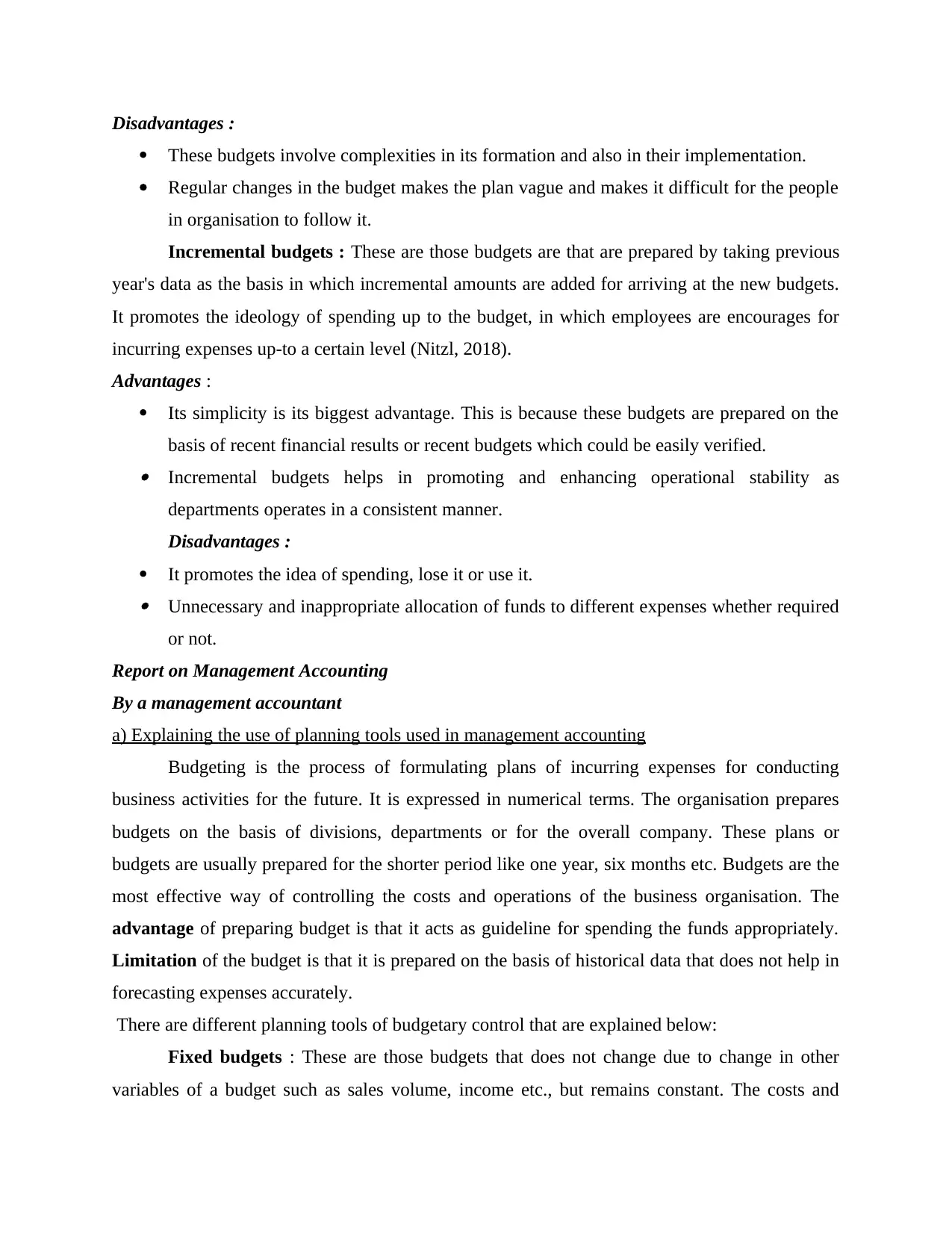
Disadvantages :
These budgets involve complexities in its formation and also in their implementation.
Regular changes in the budget makes the plan vague and makes it difficult for the people
in organisation to follow it.
Incremental budgets : These are those budgets are that are prepared by taking previous
year's data as the basis in which incremental amounts are added for arriving at the new budgets.
It promotes the ideology of spending up to the budget, in which employees are encourages for
incurring expenses up-to a certain level (Nitzl, 2018).
Advantages :
Its simplicity is its biggest advantage. This is because these budgets are prepared on the
basis of recent financial results or recent budgets which could be easily verified. Incremental budgets helps in promoting and enhancing operational stability as
departments operates in a consistent manner.
Disadvantages :
It promotes the idea of spending, lose it or use it. Unnecessary and inappropriate allocation of funds to different expenses whether required
or not.
Report on Management Accounting
By a management accountant
a) Explaining the use of planning tools used in management accounting
Budgeting is the process of formulating plans of incurring expenses for conducting
business activities for the future. It is expressed in numerical terms. The organisation prepares
budgets on the basis of divisions, departments or for the overall company. These plans or
budgets are usually prepared for the shorter period like one year, six months etc. Budgets are the
most effective way of controlling the costs and operations of the business organisation. The
advantage of preparing budget is that it acts as guideline for spending the funds appropriately.
Limitation of the budget is that it is prepared on the basis of historical data that does not help in
forecasting expenses accurately.
There are different planning tools of budgetary control that are explained below:
Fixed budgets : These are those budgets that does not change due to change in other
variables of a budget such as sales volume, income etc., but remains constant. The costs and
These budgets involve complexities in its formation and also in their implementation.
Regular changes in the budget makes the plan vague and makes it difficult for the people
in organisation to follow it.
Incremental budgets : These are those budgets are that are prepared by taking previous
year's data as the basis in which incremental amounts are added for arriving at the new budgets.
It promotes the ideology of spending up to the budget, in which employees are encourages for
incurring expenses up-to a certain level (Nitzl, 2018).
Advantages :
Its simplicity is its biggest advantage. This is because these budgets are prepared on the
basis of recent financial results or recent budgets which could be easily verified. Incremental budgets helps in promoting and enhancing operational stability as
departments operates in a consistent manner.
Disadvantages :
It promotes the idea of spending, lose it or use it. Unnecessary and inappropriate allocation of funds to different expenses whether required
or not.
Report on Management Accounting
By a management accountant
a) Explaining the use of planning tools used in management accounting
Budgeting is the process of formulating plans of incurring expenses for conducting
business activities for the future. It is expressed in numerical terms. The organisation prepares
budgets on the basis of divisions, departments or for the overall company. These plans or
budgets are usually prepared for the shorter period like one year, six months etc. Budgets are the
most effective way of controlling the costs and operations of the business organisation. The
advantage of preparing budget is that it acts as guideline for spending the funds appropriately.
Limitation of the budget is that it is prepared on the basis of historical data that does not help in
forecasting expenses accurately.
There are different planning tools of budgetary control that are explained below:
Fixed budgets : These are those budgets that does not change due to change in other
variables of a budget such as sales volume, income etc., but remains constant. The costs and
⊘ This is a preview!⊘
Do you want full access?
Subscribe today to unlock all pages.

Trusted by 1+ million students worldwide
1 out of 20
Related Documents
Your All-in-One AI-Powered Toolkit for Academic Success.
+13062052269
info@desklib.com
Available 24*7 on WhatsApp / Email
![[object Object]](/_next/static/media/star-bottom.7253800d.svg)
Unlock your academic potential
Copyright © 2020–2025 A2Z Services. All Rights Reserved. Developed and managed by ZUCOL.





